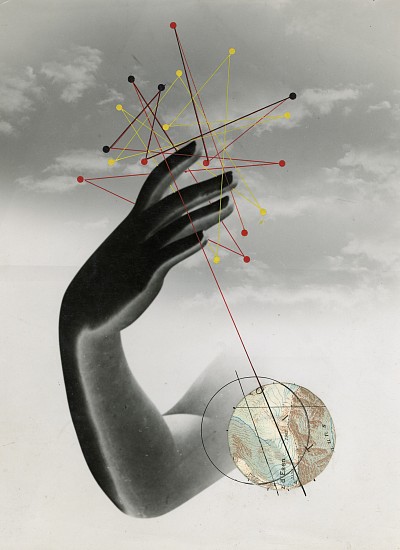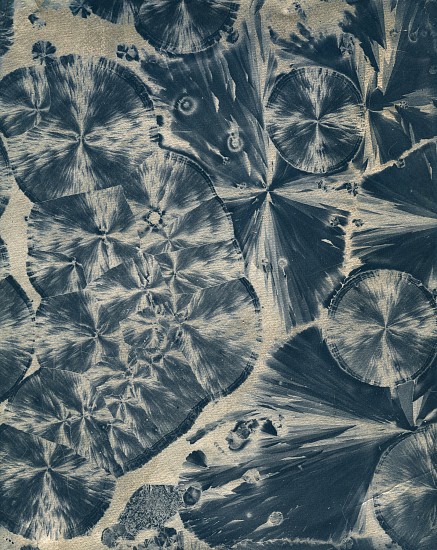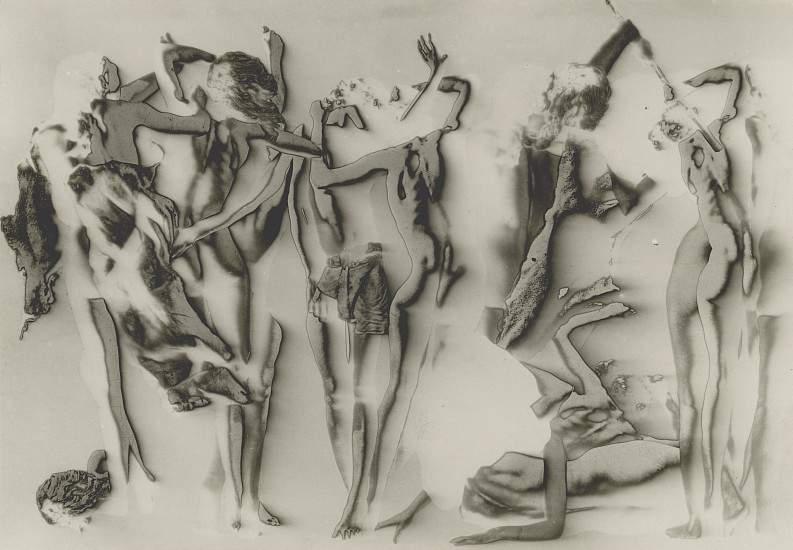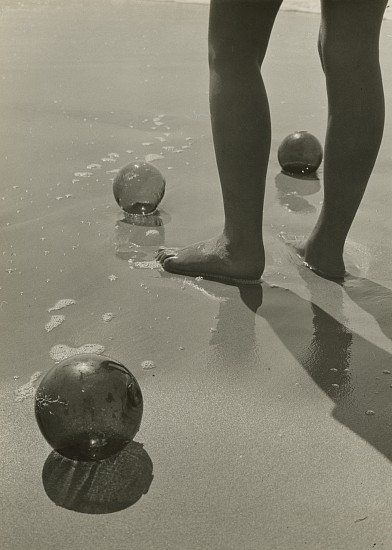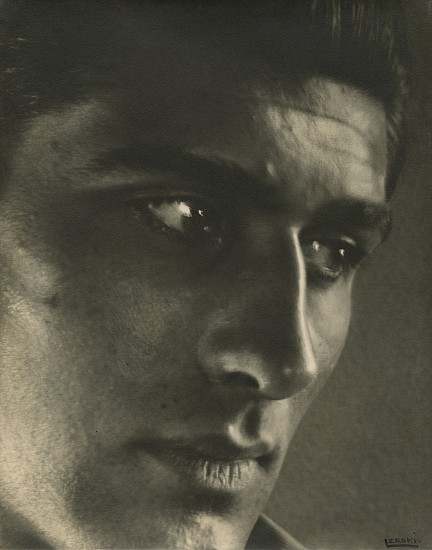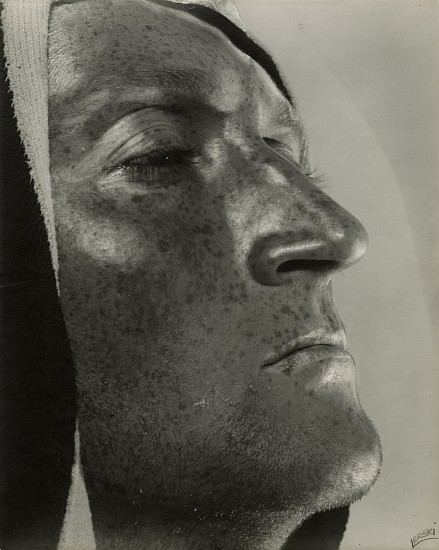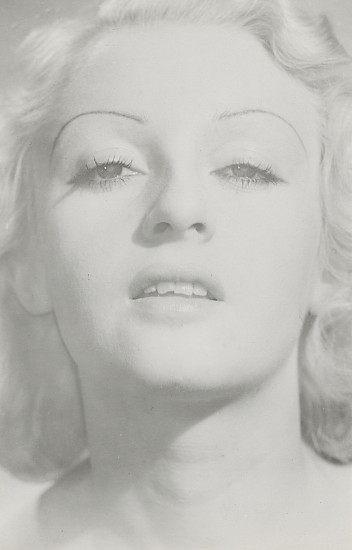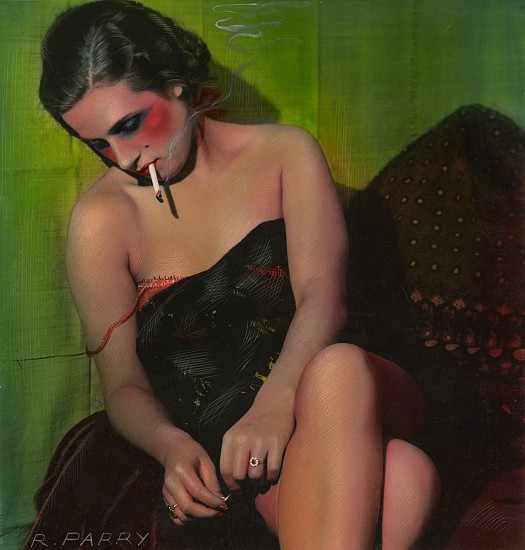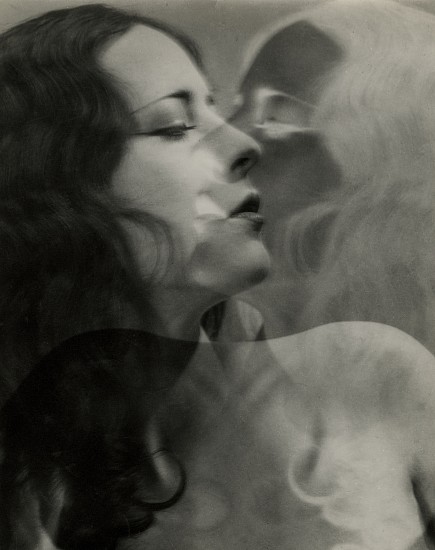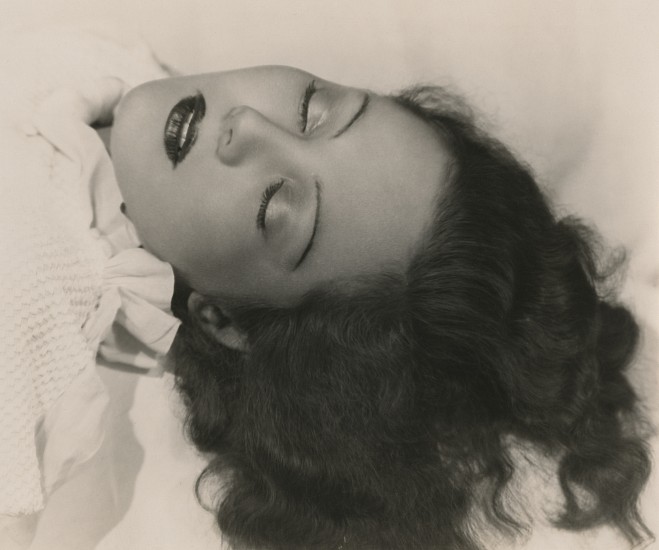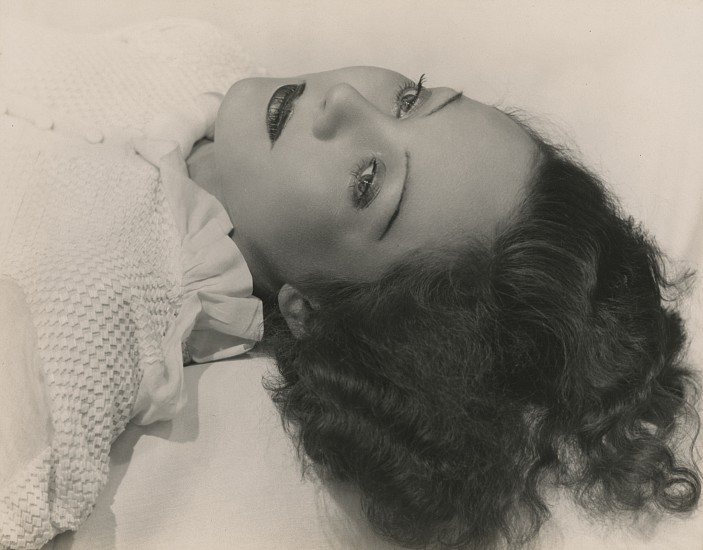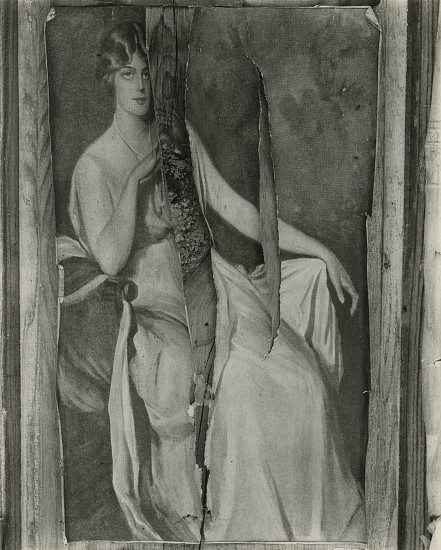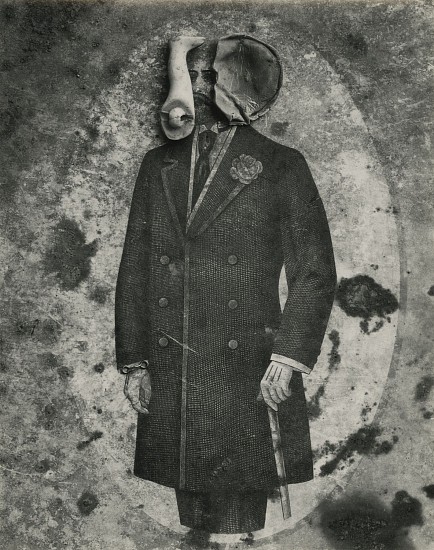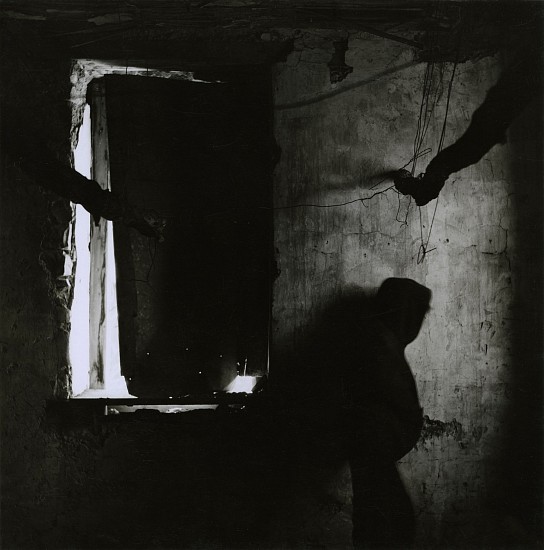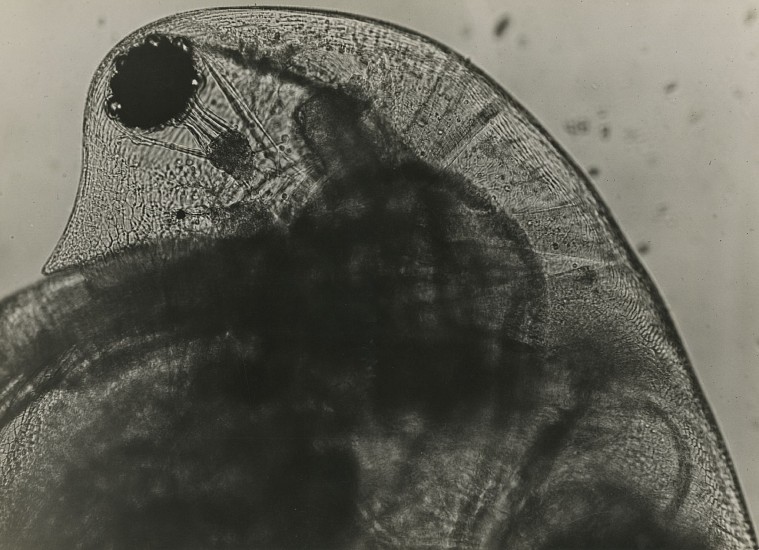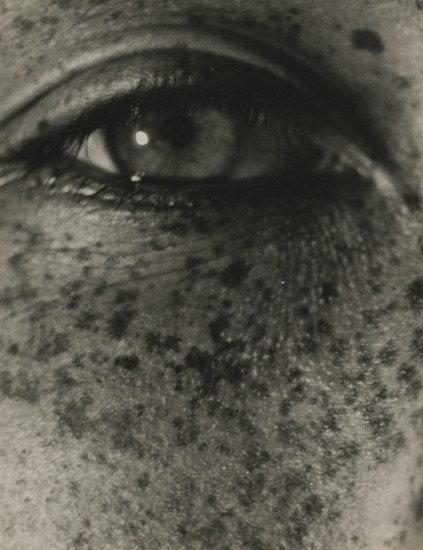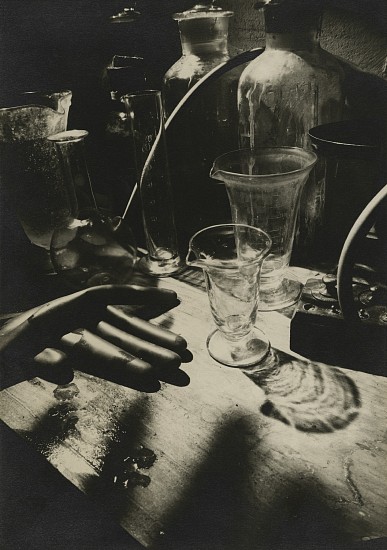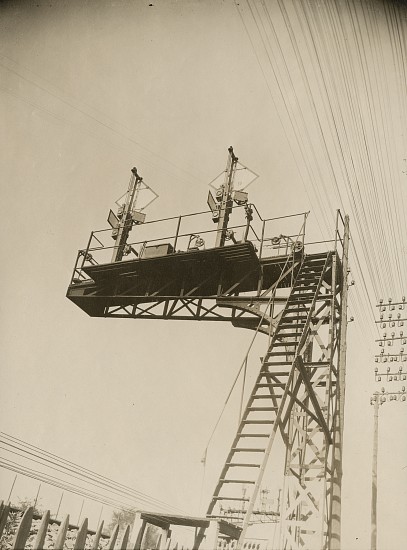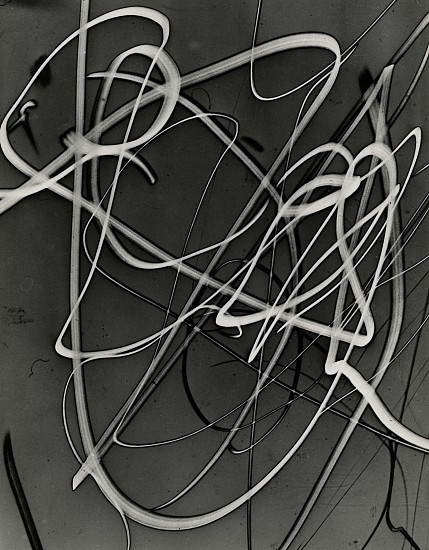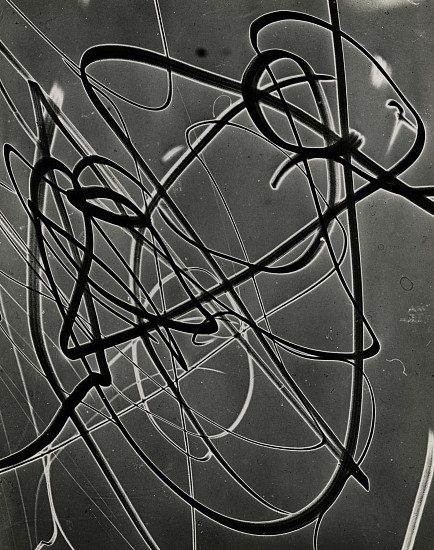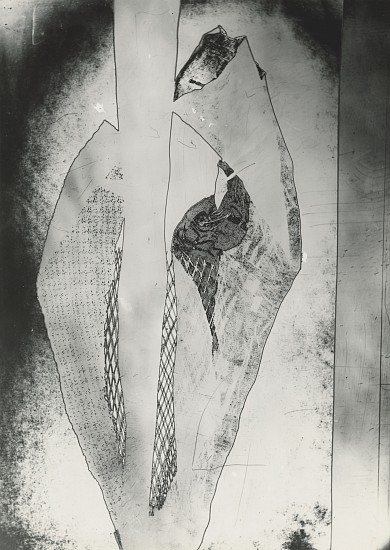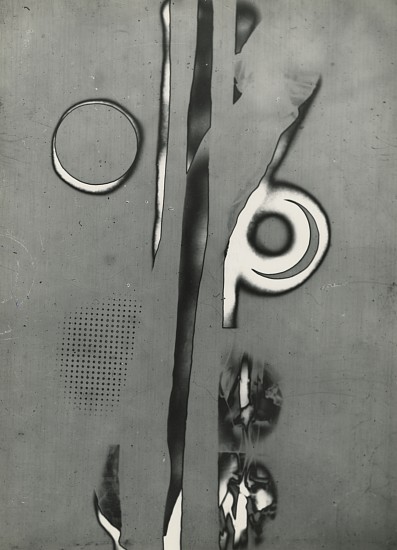More Avant-Garde



Pierre Boucher, Untitled (le bras), 1934
Vintage gelatin silver print collage, 9 5/16 x 6 13/16 in. (23.6 x 17.3 cm)
with paint/guache/ink? Photographer's stamp with date in ink and pencil and measurements in pencil on print verso.
8568
$14,000
Illustrated: Bouqueret, Christian. Pierre Bourcher: Photomonteur. Marvel, 2003, p. 70, pl. 19.



Laure Albin-Guillot, Brazilin (Brazilwood II), 1931
Vintage Fresson print, 11 1/2 x 9 3/16 in. (29.2 x 23.3 cm)
Probably with silver leaf. "Photographie de Laurae Albin-Guillot/Expo Art Deco, 1925/ Paravent Chinois fait sur métal/Pierre Fresson avait fait un paravent sur le bateau « Normandie »" in pencil on print verso.
8563
Sold
Illustrated: Micrographie Décorative. Paris: Draeger Frères, 1931, variant of Plate VII [blue not brown]. Bouqueret, Christian. Laure Albin Guillot ou La volonté d'art. Marval, 1996, p. 68.



Raoul Ubac, Combat de Penthésilée, 1937
Vintage gelatin silver print, 5 7/16 x 7 7/8 in. (13.8 x 20 cm)
Photographer's signature “R UBAC", title, date and "1er Etat collage solarisation" in photographer's hand with daughter's authentication and illustration reference and measurements in another hand in pencil on print verso.
8569
Sold
Illustrated: Bouqueret, Christian. Raoul Ubac: Photographie. Editions Léo Scheer, 2000, cat. 79, p. 89 and p. 241. Paris Capitale Photographique 1920-1040, Coll. Christian Bouqueret. Jeau de Paume/Éditions de La Martinière, 2009, p. 161.



Jean Moral, Untitled, 1931
Vintage gelatin silver print, 11 1/4 x 8 1/16 in. (28.6 x 20.5 cm)
8564
$8,000
Signed and credited "Photo Jean Moral" by photographer, with date, illustration reference and numeric notations in pencil on print verso.
Illustrated: Paris magazine, May 1935 [with the titled "reflets" (reflections)]. Bouqueret, Christian. Jean Moral: L'Oeil Capteur. Paris: Marval, 1999, p. 64, pl. 49. Paris Magazine, 1935.
Exhibited: Musée de Grenoble, 1999-2000; Musée Nicéphore Niepce, Chalon sur Saône, 2001; Musée de l'Elysée, Lausanne, 2001.
This print or possibly another print exhibited: Premier Salon international du nu photographique, Paris 1933, No. 259 and titled "reflets".



Helmar Lerski, Buchhändler (portrait of George Wittenborn, bookseller, Berlin), 1927-31
Vintage gelatin silver print, 11 7/16 x 9 in. (29.1 x 22.9 cm)
7638
$14,000
On original artist's mount. Signed in ink on print recto with Berlin studio ink stamp on mount verso.
Illustrated: Helmar Lerski, Lichtbildner: Fotografien und Filme, 1910-1947. Essen, Museum Folkwang, 1982. p. 57.
During this rich period of innovation and artistic expression, Helmar Lerski (1871-1956) photographed much of the intelligentsia of Berlin, including this young bookseller, George Wittenborn, who later immigrated to New York. Wittenborn Books was also a significant publisher and presence in the art world. When I first had this print, my former boss, Virginia Zabriskie, saw it my booth at Paris Photo in 2007 and told me it was a photograph of George Wittenborn. Though the photograph was made decades before she ever met him, Virginia said that his good looks were impossible to forget.



Helmar Lerski, Untitled from Metamorphosis through Light, 1936
Vintage gelatin silver print, 11 3/8 x 9 1/8 in. (28.9 x 23.2 cm)
8590
$10,000
Signed in pencil on print recto within image.
Illustrated: Ute Eskildsen, ed., Helmar Lerski: Metamorphosis through Light. Luca Verlag, 1982, p. 49.
From 1932-1947, Lerski lived in Palestine and photographed Jews and Arabs and made films. In 1936, over a three-month period, he made 175 photographs of one individual. This project, titled Metamorphosis through Light, can be seen as a culmination of his decades long interest in portraiture. Lerski often made multiple photographs of his sitters where each looked strikingly different from the other. He used tight compositions with strong light and shadow utilizing reflectors sheets to direct light, sometimes from multiples directions. Metamorphosis through Light is almost surreal in that it shows photographs of the same person looking like so many different people and depicts the complexity of the human character.



Émeric Feher, Untitled, c. 1937
Vintage gelatin silver print, 10 1/2 x 7 3/4 in. (26.7 x 19.7 cm)
8571
$4,000
Photographer's stamp on print verso.


Roger Parry, Untitled, 1933
Vintage gelatin silver print with hand coloring, 7 1/4 x 7 in. (18.4 x 17.8 cm)
6864
Sold
Mounted. Signed in ink on mount recto lower left corner. "Prisons de velours" (Velvet Prisons) and "Roubaud" in colored pencil on mount recto.
Design for book cover: Roubaud, Louis. La prison de velours. Paris: Gallimard, 1934.
Illustrated: Roger Parry: Photographies, dessins, mises en pages. Paris: Gallimard/Jeu de Paume, 2007 p. 104.



Francois Kollar, Untitled, c. 1933
Vintage gelatin silver print, 11 13/16 x 9 3/8 in. (30 x 23.8 cm)
Photographer's stamp on print verso.
8567
$7,500



Daniel Masclet, Les yeux clos, 1929
Vintage gelatin silver print, 8 3/8 x 10 in. (21.3 x 25.4 cm)
8570
$7,500
Signed and dated with title in a different hand in pencil on print verso.
Illustrated: Bouqueret, Christian. Daniel Masclet: Photographe Critique Théoricien. Marvel, 2001, p. 69, pl. 54.
These photographs by Masclet are believed to be of the French actress, playwright, and novelist, Odette Joyeaux, made very early in her career, most likely while she was still studying dance at the Paris Opera Ballet. It is remarkable how she looks more alive with her eyes closed. With her eyes open she resembles a mannequin, and the photograph becomes surreal. The two together allude to the Surrealists’ dedication to unleashing the expression of the subconscious, for them, a state of being beyond merely awake or asleep.


Daniel Masclet, Les yeux ouverts, 1929
Vintage gelatin silver print, 8 3/4 x 11 1/4 in. (22.2 x 28.6 cm)
6845
$7,500
Mounted. Signed in pencil on mount recto.
Illustrated: Bouqueret, Christian. Daniel Masclet: Photographe Critique Theoricien. Paris: Marval, 2001, p. 69, pl. 54 (variant).
These photographs by Masclet are believed to be of the French actress, playwright, and novelist, Odette Joyeaux, made very early in her career, most likely while she was still studying dance at the Paris Opera Ballet. It is remarkable how she looks more alive with her eyes closed. With her eyes open she resembles a mannequin, and the photograph becomes surreal. The two together allude to the Surrealists’ dedication to unleashing the expression of the subconscious, for them, a state of being beyond merely awake or asleep.



Frederick Sommer, Orminda, 1948
Vintage gelatin print; printed no later than 1949, 9 1/2 x 7 5/8 in. (24.1 x 19.4 cm)
8532
Sold
Mounted; signed, titled "Photograph" and dated in pencil on mount verso.




Frederick Sommer, Prince Albert, 1947
Vintage gelatin print; printed no later than 1949, 9 1/2 x 7 9/16 in. (24.1 x 19.2 cm)
Mounted; signed, titled "Photograph" and dated in pencil on mount verso.
8531
Price Upon Request
Provenance: Sommer to Dieter Weiss, 1949.
Frederick Sommer was drawn to Surrealism. However, like other artists of the time, he wasn’t interested in their devotion to unleashing the subconscious to explore the metaphysical. Sommer’s Prince Albert utilizes a found object, a tin of Prince Albert tobacco, on which he has placed several objects including the leg of a doll or toy. The image of Prince Albert, soon to be King Edward VII (1901-1910) of the United Kingdom, namesake of the Edwardian era, is transformed to look as if he has the head of an elephant.
Apparently, on May 21, 1887, Alexandra of Denmark (1844-1925) the Princess of Wales, Prince Albert’s wife, visited Joseph Merrick, known as the Elephant Man, at London Hospital, where he lived. “Princess Alexandra shook Merrick's hand and sat with him, an experience that left him overjoyed. She gave him a signed photograph of herself, which became a prized possession, and she sent him a Christmas card each year.” [see Wikipedia]
I am unaware of Sommer’s full intentions for this work or even if he attended to use the image from one of the most popular American tobacco brands of the time to allude to the Elephant Man, let alone the kindness of the Princess of Wales. Yet, by photographing the assemblage of objects on the image of Prince Albert, and the distressed surface of the tin, Sommer equalizes each element to the same dimension. The photograph depicts the detail and reality of the moment while alluding to the time of Prince Albert. Knowing this print was made within two years of the negative, and not reprinted later, adds further immediacy to Sommer’s expression.
Curator and art historian, Ksenya Gurshtein, (then the A.W. Mellon postdoctoral curatorial fellow in the department of photographs, National Gallery of Art, Washington) wrote an exceptional feature on Frederick Sommer for the NGA website. She stated: "Sommer did not expressly identify himself with the surrealist movement, though he exhibited with its members several times. Nevertheless, his work reveals that from the late 1930s he was interested in many of the same themes and approaches that the surrealists had begun to explore in the 1920s. The Sommers first met Max Ernst (1891–1976), a prolific surrealist, in 1941 in Los Angeles after Ernst came to the United States fleeing World War II. The friendship deepened after Ernst and his wife, Dorothea Tanning, came to visit the Sommers in 1943 and moved to Sedona, Arizona in 1946… Sommer met Man Ray (1890–1976) in 1941 at the same party in the Hollywood Hills where he met Max Ernst, and afterward the two men continued to follow each other’s work from afar…"



Ralph Eugene Meatyard, Untitled, 1960
Vintage gelatin silver print, 7 7/16 x 7 3/8 in. (18.9 x 18.7 cm)
8492
$12,000
Mounted 13 x 10 inches; signed for authentication purposes by artist's widow, "Madelyn 0. Meatyard" and "573 B - 60" in ink on mount verso.


Jean Painlevé, Daphnie, 1928
Vintage gelatin silver print, 10 5/16 x 14 1/4 in. (26.2 x 36.2 cm)
8062
$9,000
Daphnia, a genus of small planktonic crustaceans, are 0.2–5 millimetres, 0.01–0.20 in., in length. Daphnia are members of the order Cladocera, and are one of the several small aquatic crustaceans commonly called water fleas because their saltatory swimming style resembles the movements of fleas. Daphnia live in various aquatic environments ranging from acidic swamps to freshwater lakes and ponds.
Signed in ink on print verso.
Illustrated: La Revue du Medecin, No. 3, December 3, 1929: Science et cinema, p. 32. L'Art Vivant, July 1, 1931.
Jean Painleve: Le pieds dans l'eau. Edition Jeu de Paume/LienArt, 2022, p. 232.



Jean Moral, L'oeil, 1927
Vintage gelatin silver print, 11 3/8 x 8 3/4 in. (28.9 x 22.2 cm)
8565
Sold
Photographer's stamp twice with date, title and measurements in pencil on print verso.
Illustrated: Bouqueret, Christian. Jean Moral: L'Oeil Capteur. Paris: Marval, 1999, p. 83, pl. 68.



Roger Parry, Untitled, from Banalité, 1929
Vintage gelatin silver print, 9 x 6 3/8 in. (22.9 x 16.2 cm)
7779
$14,000
Double mounted. Title and date in pencil on mount recto and verso with credit stamp on mount verso.
Illustrated: Fargue, Léon-Paul and Roger Parry. Banalité. Paris: Éditions de la Nouvelle Revue Française, 1930, pl. 14.



Roger Parry, Banalité ill. 4, 1929
Vintage gelatin silver print, 8 7/8 x 6 1/2 in. (22.5 x 16.5 cm)
Rail tower
7780
$14,000
Annotated R. Parry and numbered 12 in pencil verso.
Illustrated: Fargue, Léon-Paul and Roger Parry. Banalité. Paris: Éditions de la Nouvelle Revue Française, 1930.



Raymond Journeaux, Luminoscript 43, c. 1955
Vintage gelatin silver print, 11 3/8 x 9 in. (28.9 x 22.9 cm)
Titled stamp and photographer's stamp on print verso.
8574
$4,000



Raymond Journeaux, Luminoscript, c. 1955
Vintage gelatin silver print, 11 1/2 x 9 in. (29.2 x 22.9 cm)
Photographer's name in pencil on print verso.
8573
$4,000



Jaroslav Rossler, Untitled, c. 1960s
Vintage gelatin silver print, 15 5/16 x 10 15/16 in. (38.9 x 27.8 cm)
8560
$6,500
Signed in green ink with initials in pencil and photographers stamp on print verso.























